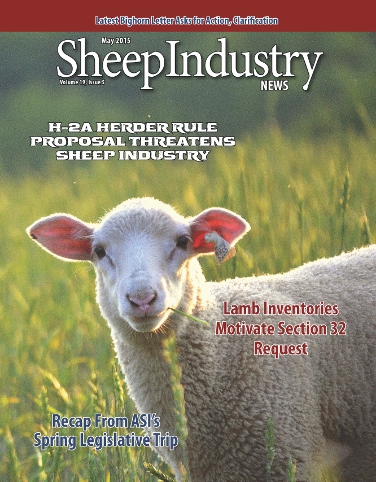
- May 2015
- President’s Notes
- Market Report
- USDA Meetings Yield Progress
- Inventories Motivate Section 32 Request
- Bighorn Letter Asks for Action, Clarification
- H-2A Proposal Calls for Extreme Wage Hikes
- News Briefs
- LRP-Lamb Expected to be Made Available in May
- Livestock Protection Dog Liability Insurance Survey
- NSIP Moving Forward
- A Standoff Approaches
- New Mill, Historic Location
- Producers Encouraged to Educate, Report, Submit
- Eight is Enough
- U.S. Hosiery Manufacturers Could Boost Market
H-2A Proposal Calls for Extreme Wage Hikes
ASI Encouraging Sheep Producers to File Comments by May 15
The U.S. Department of Labor in April issued a Federal Register posting making proposed changes to the regulations governing the employment of non-immigrant H-2A workers as sheepherders, goat herders and for the production of livestock on the open range.
The crux of the proposed rule centers around the special procedures – from mobile housing to monthly wages and year-round job duties.
As per normal process, the DOL is currently asking for comments on the amount of time herders spend on the open range, a definition of open range, the time spent at the ranch headquarters and a description of nonherding “incidental” job duties.
ASI is encouraging sheep producers to make comments on the proposed ruling by going to the Legislative Action Center on the ASI website (www.sheepusa.org). Comments must be submitted on or before May 15.
After reading the lengthy DOL rule proposal, ASI has determined that it retains mobile housing, as well as year-long job orders for sheepherders, which are critical for sheep producers and their respective businesses.
However, the proposal suggests a new wage formula. While retaining monthly wages, the formula to be used is projected to immediately double wages and eventually triple them.
Current herder rates vary by state, ranging from $750 to $1,600 per month, not including food, housing, clothing, and other supplies.
The DOL proposal would more than triple most of these wages, to between $2,125 and $3,244 per month –again not including housing, food, clothing, and supplies. The rule would “phase in” the new wage levels over five years, with employers paying 60 percent of the new rate in 2016, and then increasing 10 percent each year until producers are paying the full rate for 2020 and beyond.
The stated purpose of DOL’s massive wage hikes is to “adequately protect U.S. and H-2A workers.” Yet the proposal concedes that there are, at most, 18 U.S. workers in this occupation as of 2014.
The proposed rule also places additional limits on the use of camps and prohibit deductions or wage offsets for food and housing.
As the 30-day comment period winds down, ASI has been working with Mountain Plains Agriculture Service and Western Range Association to respond to the proposed changes. The draft talking points have been uploaded to the Legislative Action Center on ASI’s website.
Changes to the rules regarding sheepherders could be harmful to many operations.
“With more than 40 percent of U.S. sheep grazing on federal and state lands in remote areas where workers must be with the sheep at all times to move them and protect them from predators, it is critical to the future of the sheep industry that producers from across the country submit comments to the Department of Labor regarding this proposed rule,” stressed Peter Orwick, ASI executive director. “ASI has supplied general talking points, yet it will be essential for sheep producers to relay the impact of this change on their own operation – whether as an H-2A employer or as a producer concerned for the infrastructure of the sheep business if the proposal forces a large share of sheep operations out of business.”
Of importance is the fact that the court order that required DOL to put the special procedures through this “notice and comment rulemaking” did not require DOL to change any of the substance of the decades-old rules that are already in place. The purpose was to simply correct procedural issues within the current set of rules.
But the DOL appears to have used the opportunity to impose tens of millions of dollars of additional liability on employers – sheep ranchers and farmers – each year.
The DOL did acknowledge in its proposal that the changes “will have a significant economic impact on a substantial number of small entities.” At the same time, the proposal does not consider the economic impact on the businesses that supply those employers or process their products.
Studies have shown that each H-2A openrange herder position creates eight U.S. fulltime jobs. The loss of each H-2A position will mean the loss of those jobs, largely in small western towns. The proposal has no calculation of the cost of family farms forced to liquidate their herds and end a generations-old tradition.
The H-2A visa program allows U.S. producers to hire foreign workers when they are unable to recruit enough U.S. workers for the job. These workers come to the U.S. for up to three years and then return to their home country. Open-range sheep and cattle producers in general, have not been able to hire U.S. workers for years. Last year, Western Range Association and Mountain Plains Agriculture Service each had approximately 1,000 herder jobs to fill. Between them, they had only 2 or 3 qualified U.S. workers that applied for those 2,000 jobs.

